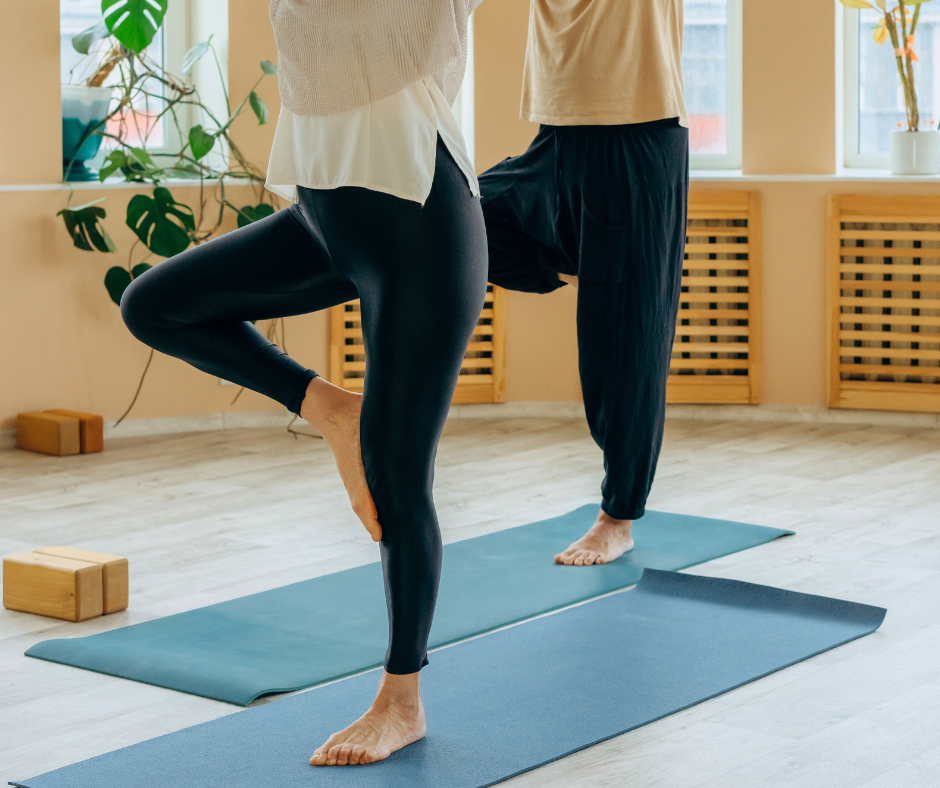-
Boost Your Balance & Prevent Dangerous Falls!

Falls Prevention Awareness Month truly matters. After all, the risk it addresses is all too real: according to the CDC, one in four adults over 65 will fall, making it a leading cause of serious injury. In this post, Kentlands Foot & Ankle Center explores common risk factors and shares how you can improve your balance, too!
The 10-Second Balance Test
How can you tell if you’re at risk of falling? All you need is 10 seconds and a chair!
- Stand on a flat, non-slip surface near a counter or sturdy chair you can grab if needed.
- Lift one foot off the ground. Keep your elevated foot from touching your standing leg!
- Cross your arms over your chest.
- Try to hold this position for 10 seconds without touching down or grabbing for support.
Could you do it? If you felt unsteady or had to put your foot down, it’s not just a sign of “getting older.” It’s a signal that your body’s balance system needs attention.
How Do Your Feet Affect Your Balance?
Your feet are complex structures designed to keep you stable and upright. When problems arise, they can compromise your entire body’s balance in several ways:
- A Faulty Foundation: Foot deformities like bunions or hammertoes, or alignment issues like flat feet, can change the way your foot meets the ground.
- This creates an unstable base, forcing your ankles, knees, and hips to work overtime to compensate, which can easily throw you off balance.
- Scrambled Signals: Your feet are packed with nerves that send constant information to your brain about your position in space (a sense called proprioception).
- Conditions like diabetic neuropathy or even just the stiffness from arthritis can interfere with these signals. When the brain doesn’t get a clear message from the feet, your stability suffers.
- Pain and Compensation: When you have a painful spot on your foot, you naturally change the way you walk to avoid putting pressure on it.
- This altered gait—a limp or a shuffle—is an unnatural movement pattern that can significantly compromise your balance and increase your risk of a fall.
The Podiatrist’s Role: Rebuilding Your Foundation
As foot and ankle specialists, our goal is to address these foundational issues to improve your stability. A key tool in our arsenal for fall prevention is the custom orthotic.
Unlike a flimsy store-bought insole, a custom orthotic is a prescription medical device created from a precise mold of your feet. It works to improve balance by:
- Correcting Misalignment: An orthotic provides targeted support to correct issues like flat feet or overpronation, creating a stable, properly aligned foundation for your entire body.
- Redistributing Pressure: By evening out the pressure across your foot, orthotics can significantly reduce pain from conditions like arthritis or bunions, allowing you to walk with a more natural, stable gait.
- Improving Sensory Feedback: For some patients, orthotics can improve the sensory signals being sent from the feet to the brain, providing a clearer sense of position and stability.
It’s important to note that regular exercise and stretching can make a difference, too!
Get In Touch and Stay Stable!
If you or a loved one is concerned about their balance or has experienced a fall, don’t wait. Schedule a comprehensive fall risk assessment with our team today!
Get in touch for a comprehensive foot examination with Kentlands Foot & Ankle Center podiatrist Dr. Jon M. Sherman. To make your appointment, please call our office at 301-825-9697. You can also contact us online.
-
Keep Your Feet Flowing: Blood Flow and Circulation in the Lower Extremities

February is American Heart Month, a timely reminder to prioritize our cardiovascular well-being. However, while most focus remains on the heart itself, its connection to our feet and lower extremities tends to go unnoticed.
The truth is that healthy blood flow and circulation are crucial for happy, healthy feet. Let the team at Kentlands Foot & Ankle Center delve into this vital relationship for you! Together, we’ll explore how to keep your feet flowing freely.
Heart Health Basics
Your heart pumps tirelessly and constantly, sending oxygen-rich blood throughout your body. But that doesn’t mean there aren’t any problems.
- In terms of distance, your heart works hardest to send blood to your feet, which are as far away from it as possible.
- When this intricate system functions well, your feet receive the nutrients they need to stay healthy and function optimally.
- When something goes amiss, your feet are typically the first to find out.
When the Flow Filters
Disruptions to your circulation tend to translate into problems for your feet.
- Conditions like peripheral artery disease (PAD) – which affects nearly 34 million Americans – narrow arteries, restricting blood flow to the lower extremities.
- This can lead to symptoms such as pain, numbness, and even tissue damage in severe cases.
Circulation Education
Fortunately, several measures can promote healthy blood flow and circulation in your feet:
- Regular exercise, including walking, improves circulation throughout your body, including your lower extremities.
- Avoid tight shoes that constrict blood vessels in your feet.
- If you have diabetes or high blood pressure, work with your doctor to manage these conditions effectively.
- Consult a podiatrist promptly for any concerns like pain, numbness, or changes in skin color or texture.
When in doubt, it never hurts to consult a DPM with a proven reputation for knowing how to handle all kinds of foot and ankle complications!
Schedule a comprehensive foot examination with Kentlands Foot and Ankle Center podiatrist Dr. Jon M. Sherman. To make your appointment, please call our office at 301-330-5666.
-
Put Your Best Foot Forward

April is National Foot Health Awareness Month and it is also the perfect time to think about how much we count on our feet each day, and how important it is to develop healthy habits to keep them free of pain. According to the American Podiatric Medical Association, approximately 20 percent of the U.S. population has at least one-foot problem annually. At Kentlands Foot and Ankle Center, our podiatrist, Dr. Jon M. Sherman, is Board Certified in Foot Surgery by the American Board of Podiatric Surgery. Dr. Sherman is also a Fellow of the American College of Foot and Ankle Surgeons, all of which set him apart from other podiatrists.
Fun Facts About Feet
- Each foot is composed of 26 bones, 33 joints, and over 100 muscles and tendons.
- Together both feet contain 1/4 of the bones in the entire body.
- The average person, over their lifetime, will walk approximately the same distance as if they had walked around the earth 4 times.
- 5 times a person’s body weight is transmitted through each foot with every step!
How To Maintain Healthy Feet
Do:
- Try foot massages or reflexology.
- Soak your feet in Epsom salt if they are sore.
- Change your socks daily.
Don’t:
- Share footwear
- Wear poor-fitting shoes
- Try “DIY” fixes for your foot problems
When To Visit a Podiatrist
The field of podiatry strives to improve the overall health and well-being of patients by focusing on preventing, diagnosing, and treating conditions associated with the foot and ankle. It is time to see a podiatrist anytime you have foot or ankle discomfort, changes in the appearance of your feet, abnormal growth, an injury, or a medical condition that affects your feet. It is also very important to have an annual check-up with your podiatrist to maintain healthy feet.
To schedule an appointment at our Gaithersburg, MD office, please call (301) 330-5666 or visit our website for more information.
RECENT POSTS
categories
- Uncategorized
- Featured Articles
- Foot Disorders
- Broken Ankle
- Broken Toe
- Fracture
- Foot Health
- Foot Care
- Arthritis
- Foot Pain
- Skin Cancer
- Podiatry Appointment
- Custom Orthotics
- Podiatrist
- Diabetes
- Gout
- Heart Health
- National Nutrition Month
- National Foot Health Awareness Month
- Foot Safety
- Foot and Ankle Injuries
- Falls Prevention
- Chronic Heel Pain
- Shoes
- Laser Therapy
- Quoted
- Physical Therapy
- KeryFlex
- Sweat
- Summer Foot Care
- Sports Injury
- ESWT
- Fungal Toenails
- Bunion
- Plantar Fasciitis
- PinPointe Laser
- Heel Pain


